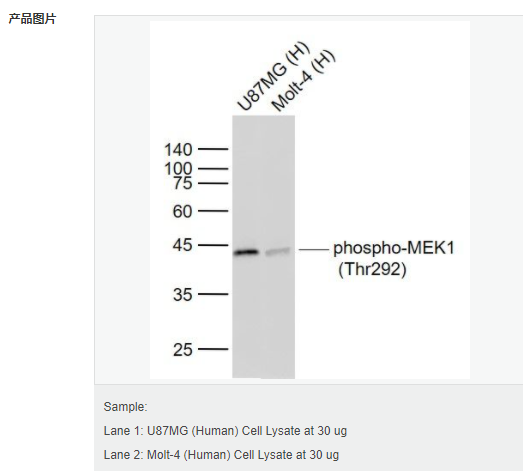

貨號(hào)
產(chǎn)品規(guī)格
售價(jià)
備注
BN42098R-50ul
50ul
¥2020.00
交叉反應(yīng):Human 推薦應(yīng)用:WB,IHC-P,IHC-F,ICC,IF
BN42098R-100ul
100ul
¥3240.00
交叉反應(yīng):Human 推薦應(yīng)用:WB,IHC-P,IHC-F,ICC,IF
產(chǎn)品描述
| 英文名稱 | phospho-MEK1 (Thr292) |
| 中文名稱 | 磷酸化絲裂原活化蛋白激酶1重組兔單克隆抗體 |
| 別 名 | MEK1(T292); MEK1 (phospho T292); p-MEK1 (phospho T292); MEK1(Phospho Thr292); MEK1(Phospho T292); p-MEK1(Thr292); p-MEK1(T292); Dual specificity mitogen activated protein kinase kinase 1; ERK activator kinase 1; MAP kinase kinase 1; MAP kinase/Erk kinase 1; MAP/Erk kinase 1; Map2K1; MAPK/ERK kinase 1; MAPKK 1; MAPKK1; MEK 1; MEKK1; Mitogen activated protein kinase kinase 1; MKK 1; MKK1; PRKMK 1; PRKMK1;Protein kinase mitogen activated kinase 1 (MAP kinase kinase 1); Protein kinase mitogen activated kinase 1; Protein kinase mitogen activated, kinase 1; MP2K1_HUMAN. |
| 產(chǎn)品類型 | 磷酸化抗體 |
| 研究領(lǐng)域 | 腫瘤 免疫學(xué) 信號(hào)轉(zhuǎn)導(dǎo) 轉(zhuǎn)錄調(diào)節(jié)因子 激酶和磷酸酶 |
| 抗體來(lái)源 | Rabbit |
| 克隆類型 | Monoclonal |
| 克 隆 號(hào) | 3F10 |
| 交叉反應(yīng) | Human, |
| 產(chǎn)品應(yīng)用 | WB=1:500-2000 IP=1:20-100 IHC-P=1:50-200 IHC-F=1:50-200 ICC=1:50-200 IF=1:50-200 (石蠟切片需做抗原修復(fù)) not yet tested in other applications. optimal dilutions/concentrations should be determined by the end user. |
| 分 子 量 | 43kDa |
| 細(xì)胞定位 | 細(xì)胞核 細(xì)胞漿 |
| 性 狀 | Liquid |
| 濃 度 | 1mg/ml |
| 免 疫 原 | KLH conjugated Synthesised phosphopeptide derived from human MEK1 around the phosphorylation site of Thr292:PR(p-T)PG |
| 亞 型 | IgG |
| 純化方法 | affinity purified by Protein A |
| 儲(chǔ) 存 液 | 0.01M TBS(pH7.4) with 1% BSA, 0.03% Proclin300 and 50% Glycerol. |
| 保存條件 | Shipped at 4℃. Store at -20 °C for one year. Avoid repeated freeze/thaw cycles. |
| PubMed | PubMed |
| 產(chǎn)品介紹 | The protein encoded by this gene is a member of the dual specificity protein kinase family, which acts as a mitogen-activated protein (MAP) kinase kinase. MAP kinases, also known as extracellular signal-regulated kinases (ERKs), act as an integration point for multiple biochemical signals. This protein kinase lies upstream of MAP kinases and stimulates the enzymatic activity of MAP kinases upon wide variety of extra- and intracellular signals. As an essential component of MAP kinase signal transduction pathway, this kinase is involved in many cellular processes such as proliferation, differentiation, transcription regulation and development. Function: Dual specificity protein kinase which acts as an essential component of the MAP kinase signal transduction pathway. Binding of extracellular ligands such as growth factors, cytokines and hormones to their cell-surface receptors activates RAS and this initiates RAF1 activation. RAF1 then further activates the dual-specificity protein kinases MAP2K1/MEK1 and MAP2K2/MEK2. Both MAP2K1/MEK1 and MAP2K2/MEK2 function specifically in the MAPK/ERK cascade, and catalyze the concomitant phosphorylation of a threonine and a tyrosine residue in a Thr-Glu-Tyr sequence located in the extracellular signal-regulated kinases MAPK3/ERK1 and MAPK1/ERK2, leading to their activation and further transduction of the signal within the MAPK/ERK cascade. Depending on the cellular context, this pathway mediates diverse biological functions such as cell growth, adhesion, survival and differentiation, predominantly through the regulation of transcription, metabolism and cytoskeletal rearrangements. One target of the MAPK/ERK cascade is peroxisome proliferator-activated receptor gamma (PPARG), a nuclear receptor that promotes differentiation and apoptosis. MAP2K1/MEK1 has been shown to export PPARG from the nucleus. The MAPK/ERK cascade is also involved in the regulation of endosomal dynamics, including lysosome processing and endosome cycling through the perinuclear recycling compartment (PNRC), as well as in the fragmentation of the Golgi apparatus during mitosis. Subunit: Found in a complex with at least BRAF, HRAS1, MAP2K1, MAPK3/ERK1 and RGS14 (By similarity). Forms an heterodimer with MAP2K2/MEK2. Forms heterodimers with KSR2 which further dimerize to form tetramers. Interacts with ARBB2, LAMTOR3, MAPK1/ERK2, MORG1 and RAF1. Interacts with PPARG and with isoform 1 of VRK2. Interacts with Yersinia yopJ. Interacts with SGK1. Interacts with BIRC6/bruce. Subcellular Location: Cytoplasm, cytoskeleton, centrosome. Cytoplasm, cytoskeleton, spindle pole body. Cytoplasm. Nucleus. Note=Localizes at centrosomes during prometaphase, midzone during anaphase and midbody during telophase/cytokinesis. Tissue Specificity: Widely expressed, with extremely low levels in brain. Post-translational modifications: Phosphorylation at Ser-218 and Ser-222 by MAP kinase kinase kinases (RAF or MEKK1) positively regulates kinase activity. Also phosphorylated at Thr-292 by MAPK1/ERK2 and at Ser-298 by PAK. MAPK1/ERK2 phosphorylation of Thr-292 occurs in response to cellular adhesion and leads to inhibition of Ser-298 phosphorylation by PAK. Similarity: Belongs to the protein kinase superfamily. STE Ser/Thr protein kinase family. MAP kinase kinase subfamily. Contains 1 protein kinase domain. SWISS: Q02750 Gene ID: 5604 Database links: Entrez Gene: 5604 Human Entrez Gene: 26395 Mouse Omim: 176872 Human SwissProt: Q02750 Human SwissProt: P31938 Mouse Unigene: 145442 Human Unigene: 248907 Mouse Unigene: 5850 Rat Important Note: This product as supplied is intended for research use only, not for use in human, therapeutic or diagnostic applications. |
